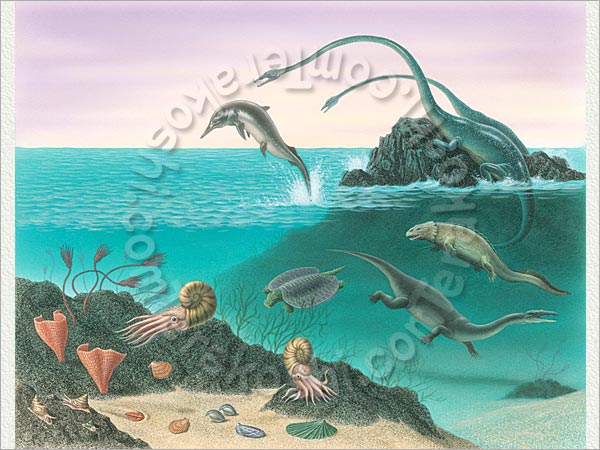 252 million years ago about 90% of life on planet earth died. This was known as the Permian–Triassic extinction event. OK, so let’s be a tad more precise about the percentages of what happened …
252 million years ago about 90% of life on planet earth died. This was known as the Permian–Triassic extinction event. OK, so let’s be a tad more precise about the percentages of what happened …
The end Permian was the greatest natural catastrophe experienced by life on Earth with its impact recorded in terrestrial and marine rock archives. About 90% of marine species, 70% of terrestrial vertebrate species, 30% of insect orders and an indeterminate percentage of terrestrial and marine plants succumbed during this catastrophe
Why did this happen?
There are basically three suggested mechanisms as follows …
Suggested mechanisms for the latter include one or more large meteor impact events, massive volcanism such as that of the Siberian Traps, and the ensuing coal or gas fires and explosions,[16] and a runaway greenhouse effect triggered by sudden release of methane from the sea floor due to methane clathrate dissociation or methane-producing microbes known as methanogens;[17] possible contributing gradual changes include sea-level change, increasing anoxia, increasing aridity, and a shift in ocean circulation driven by climate change.
There is a new paper
A new paper has been published in Palaeoworld that makes a case for it being the sudden release of vast amounts of methane into the atmosphere.
Methane Hydrate: Killer cause of Earth’s greatest mass extinction
Measurements of gases vaulted in calcite of end Permian brachiopods and whole rock document significant differences in normal atmospheric equilibrium concentration in gases between modern and end Permian seawaters. The gas composition of the end Permian brachiopod-inclusions reflects dramatically higher seawater carbon dioxide and methane contents leading up to the biotic event. Initial global warming of 8–11 °C sourced by isotopically light carbon dioxide from volcanic emissions triggered the release of isotopically lighter methane from permafrost and shelf sediment methane hydrates. Consequently, the huge quantities of methane emitted into the atmosphere and the oceans accelerated global warming and marked the negative δ13C spike observed in marine carbonates, documenting the onset of the mass extinction period. The rapidity of the methane hydrate emission lasting from several years to thousands of years was tempered by the equally rapid oxidation of the atmospheric and oceanic methane that gradually reduced its warming potential but not before global warming had reached levels lethal to most life on land and in the oceans. Based on measurements of gases trapped in biogenic and abiogenic calcite, the release of methane (of ∼3–14% of total C stored) from permafrost and shelf sediment methane hydrate is deemed the ultimate source and cause for the dramatic life-changing global warming (GMAT > 34 °C) and oceanic negative-carbon isotope excursion observed at the end Permian.
I can almost hear the distinct sound of eyes glazing over.
Here however is a rather stark kicker …
Global warming triggered by the massive release of carbon dioxide may be catastrophic, but the release of methane from hydrate may be apocalyptic. The end Permian holds an important lesson for humanity regarding the issue it faces today with greenhouse gas emissions, global warming, and climate change.
There are a couple of important points to raise here
Point 1 – This is part of the on-going conversation
The publication of such a paper, any paper in fact, is not necessarily the definitive and final word, but instead is part of the on-going conversation within the scientific community.
What caused the Permian–Triassic extinction event has been an ongoing topic of debate with various ideas being proposed to explain it. This paper presents new data, specifically, measurements of gases vaulted in calcite of end Permian brachiopods and whole rock. This clearly documents dramatically higher seawater carbon dioxide and methane content leading up to the extinction event, and so knowing that enables the authors of the paper to then propose specific conclusions.
Others reading that paper might or might not agree with the conclusions, and so the debate continues.
Point 2 – Could something like this happen to us today?
We can’t draw that conclusion from this.
The title of the paper is a tad dramatic and so is the suggestion that this is what might happen to us. Nevertheless, the new data can’t simply be ignored.
The idea that an arctic melt could release vast amounts of methane is a serious possibility and one of the many possible outcomes, but it is by no means a certainty.
The observation that we are warming the climate today is a measured reality. The fact that the root cause of this is the vast amount of CO2 we are pumping into the atmosphere is more or less universally accepted by every serious climate scientist.
What comes next is not wholly certain in the long term. Run the various models and you do get a range of outcomes of which the most probable threats to our civilisation include rising sea level flooding major costal cities and also extreme weather events (droughts, floods, intense storms, etc..).
Should we be worried?
In no uncertain terms – yes, but let’s not lapse into un-warrented end-of-the-world predictions that are not probabilities, but instead is simply speculation. However, thinking through all the possible scenarios and speculating is wholly appropriate.